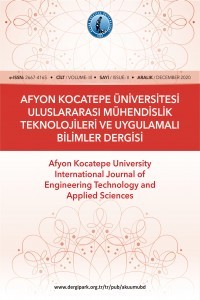CT Taramalarında Hastanın kilosuna göre alınan dozun değişimi
CT, Phantom, NCICT, Monte Carlo
Variation of the Absorbed Dose by the Weight of the Patient in CT Scanning
CT, Phantom, NCICT, Monte Carlo,
___
- 1. AAPM, 2011. Size-specific dose estimates (ssde) in pediatric and adult body ct examinations, AAPM Report 204, 1-30.
- 2. Lee, C., Kim, K.P., Bolch, W.E., Moroz, B.E. and Folio, L., 2015. NCICT: a computational solution to estimate organ doses for pediatric and adult patients undergoing CT scans, J Radiol Prot, 35, 4, 891-909.
- 3. National Research Council, 2006. Health Risks from Exposure to Low Levels of Ionizing Radiation: BEIR VII Phase 2, Washington DC, National Academies Press.
- 4. Lee, C., Kim, K.P., Long, D. and Bolch, W.E., 2012. Organ doses for reference pediatric and adolescent patients undergoing computed tomography estimated by Monte Carlo simulation, Med Phys, 39, 2129–46.
- 5. Lee, C., Kim, K.P., Long, D., Fisher, R., Tien, C., Simon, S.L., Bouville, A. and Bolch, W.E., 2011. Organ doses for reference adult male and female undergoing computed tomography estimated by Monte Carlo simulations, Med Phys, 38, 1196–206.
- 6. Lee, E., Lamart, S., Little, M.P. and Lee, C., 2014. Database of normalised computed tomography dose index for retrospective CT dosimetry, J Radiol Protect, 34, 363–88.
- 7. Reiser, M.F., Takahashi, M., Modic, M. and Becker, C.R., 2004. Multislice CT, ed. Reiser, M.F., et al., Berlin, Springer. Sechopoulos, I., Trianni, A. and Peck, D., 2015. The DICOM radiation dose structured report: what it is and what it is not, J Am Coll Radiol, 12, 712–3.
- 8. Turner, A.C., Zankl, M., DeMarco, J.J., Cagnon, C.H., Zhang, D., Angel, E., Cody, D.D., Stevens, D.M., McCollough, C.H. and McNitt-Gray, M.F., 2010. The feasibility of a scanner-independent technique to estimate organ dose from MDCT scans: using CTDIvol to account for differences between scanners, Med Phys, 37, 1816.
- Yayın Aralığı: Yılda 2 Sayı
- Başlangıç: 2018
- Yayıncı: Afyon Kocatepe Üniversitesi
Tuba Nur SERTTAŞ, Fatih SERTTAŞ, Fatih Onur HOCAOĞLU
RLBP Metodu ile Mamografi Görüntülerinin İncelenmesi ve Sınıflandırılması
Muhammed Mustafa KELEK, Enes CENGİZ, Yüksel OĞUZ, Ahmet YÖNETKEN
Kalp Krizi ve Alternatif tedaviler
Selcan KOCAMAN, Mine DOSAY-AKBULUT
CT Taramalarında Hastanın kilosuna göre alınan dozun değişimi
İsmail Hakkı SARPÜN, Cengiz ÖZSOY, Vedat AYDIN, Timur KOCA
MPPT Yöntemi ile İki Aşamalı Üç Fazlı Şebeke Bağlantılı Fotovoltaik Sistem
Mehmet DAYIOĞLU, Yüksel OĞUZ, Ahmet YÖNETKEN
112Sn(α, ) 116Te Reaksiyonu için Astrofiziksel S-Faktörlerinin ve Reaksiyon Hızlarının Hesaplanması
Ercan YILDIZ, Abdullah AYDIN, İsmail Hakkı SARPÜN
I-131 Radyoizotop Aktivitelerinin Nükleer Tıpta Kullanılan Organ Dozu Üzerine Etkisi
Timur KOCA, İsmail Hakkı SARPÜN, Cengiz ÖZSOY, Vedat AYDIN, Selcan ŞAHİN
AA6061 T6 Alüminyum Alaşımında Bilyeli Dövme İşleminin Mekanik Özelliklere Etkisinin İncelenmesi
Erkek Çocuklarda I-131 Radyoizotopunun Vücut Dozunun Yaşa Göre Değişimi
Timur KOCA, İsmail Hakkı SARPÜN, Ünal YILDIRIR, İlkay TÜRK ÇAKIR, Selcan ŞAHİN
